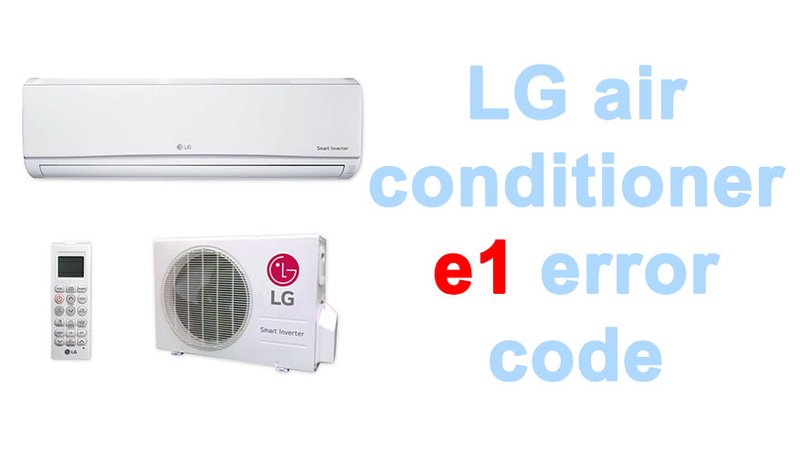
Error codes in your LG air conditioner, specifically the E1 error, usually indicate a problem with the unit’s sensors or wiring. In simpler terms, it’s like your AC is trying to communicate something by flashing a digital S.O.S. While these codes can seem like a mystery, they are usually the device’s way of telling you there’s a hiccup in its functioning. Fortunately, by learning to interpret these signals, you can take steps to prevent them and keep your home comfortably cool.
Understanding the E1 Error Code
So, what exactly does the E1 error code mean? Think of your air conditioner as a multifaceted machine where every part plays a crucial role, much like an orchestra playing a symphony. When one instrument is out of tune, it affects the whole performance. In the case of an E1 error, it’s as if one of the players in this mechanical orchestra is having trouble keeping up.
The E1 error in LG air conditioners generally points to an issue with the temperature sensor. This tiny part acts like the thermostat in your home, constantly reading the room’s temperature and relaying that information to the AC’s control board. If this sensor is misreading or not operating correctly, the AC may not function as it should. It’s like trying to drive a car with a faulty fuel gauge; you won’t quite know when to fill up, and in this case, your AC won’t know when to cool down.
If we don’t address this issue, it can lead to inefficient cooling and increased energy bills. Just imagine leaving a window open in the middle of winter—it’s the same kind of wastefulness! That’s why it’s essential to fix this problem and prevent it from happening again.
Common Causes of the E1 Error Code
You might be wondering, “Why does this error happen in the first place?” Good question! Several factors can contribute to the appearance of the E1 error code, but let’s break it down to the most common culprits.
Firstly, a dirty or clogged air filter can strain your unit. Imagine trying to breathe through a thick scarf. It’s uncomfortable, right? Similarly, if the air filter in your AC is clogged, the air can’t flow properly, causing the unit to overwork and sometimes throw up an E1 error. Regularly cleaning or replacing your air filter can prevent surprise error codes.
Secondly, wiring issues can also be a cause. Over time, the electrical connections inside your AC can loosen or corrode. It’s like when the batteries in a toy start to run out; the toy’s performance becomes erratic. Similarly, faulty wiring can disrupt the communication between components leading to an E1 error.
Lastly, sensor problems themselves can arise from wear and tear. Just like how our senses can dull over time, the temperature sensor in your AC can become less effective, leading to miscommunication with the system. Periodically checking and, if necessary, replacing these sensors can help keep the error codes at bay.
Maintaining Your Air Conditioner to Prevent Future Errors
Now that we know what causes the E1 error, let’s talk about keeping it from happening again. Maintenance is like routine doctor visits for your AC; it’s crucial!
Start with regular cleaning. Dust and grime might seem insignificant, but they can lead to bigger problems. Think of it like plaque on your teeth—neglect it, and you’re in for a painful dentist visit. Clean the filters monthly and the coils at least annually to ensure your AC can breathe properly and run efficiently.
Besides cleaning, check the wiring and connections. Just as you would ensure the charger is correctly plugged into your phone, make sure all connections are secure and corrosion-free. It might seem technical, but anyone can learn to recognize worn wires with a bit of practice.
Lastly, monitor the performance of your AC. If something feels off or the room isn’t cooling as it used to, don’t wait for an error code. Proactively calling in a professional for a quick check can save you from more significant issues down the line.
Next Steps and Preventative Tips
Imagine your air conditioner as a team player in your household’s comfort lineup. Keeping it in top condition is less about reacting to problems and more about preventing them. What should you do next to ensure you’re not caught off guard by an E1 error in the future?
First, make a habit of checking your AC’s components regularly. Create a simple checklist, perhaps set a reminder on your phone—it’s easy to overlook these things, but regular check-ups go a long way.
Secondly, invest in a surge protector for your unit. Why? Power surges can disrupt and damage the delicate electronics in your AC, prompting error codes. It’s like wearing a helmet when cycling—an ounce of prevention can save a lot of pain.
Lastly, consider scheduling professional maintenance at least once a year. Professionals can spot potential problems early on and advise you on the best course of action, much like having a trusted mechanic for your car.
By taking these steps, not only will you prevent the E1 error, but you’ll also extend the life of your air conditioner. Remember, a little attention now can result in a lot more comfort later. Here’s to cool, trouble-free summers!